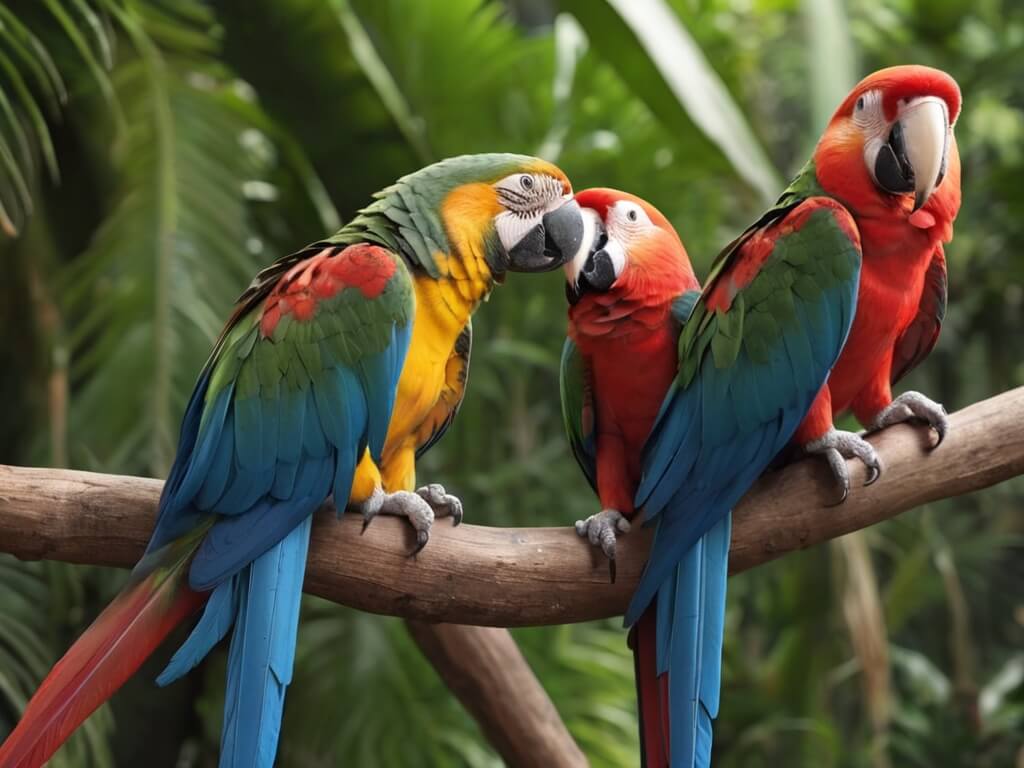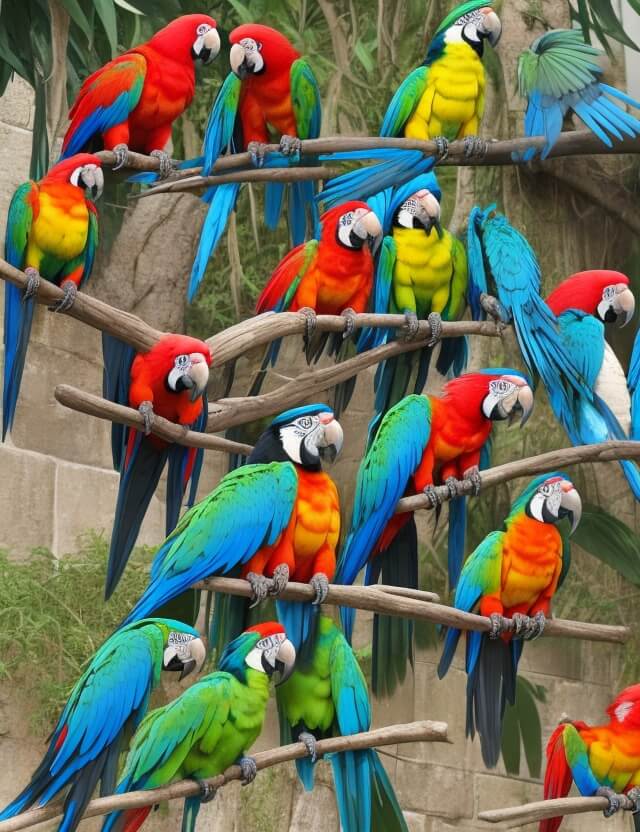Discover the fascinating world of macaws, a diverse group of parrots known for their vibrant colors and unique characteristics. From the scarlet red and blue macaw to the majestic hyacinthine macaw, learn about their habitats, behaviors, and the challenges of keeping them as pets.

MACAW, a name used for about 23 kinds of birds belonging to the order of parrots (Psittaciformes). All have long, pointed tails and in most the face is bare of feathers. While many are noted for gaudiness of plumage, others are chiefly dull green. The macaws range in the American tropics from Mexico to Uruguay and Argentina, with a concentration of at least 12 kinds in Brazil alone.
They are at home in the great rain forests, where they usually stay high in the trees, feeding on fruits and nuts which they are able to crack with their immensely powerful beaks. They are monogamous, and when seen in flight along the great rivers of South America, or high above the trees, they are invariably in pairs or small family parties of three or four. Two or three white eggs are laid in a cavity in a tree.
Macaws are familiar to many as inhabitants of zoological gardens but are also frequently kept as household pets. Most of the specimens seen in captivity have been taken from the nest in their native lands and reared by hand so that, if well treated, they remain tame and gentle. On the other hand, those that may have been mistreated, as well as those captured as adults, may be savage and even dangerous to persons who approach them too closely, since they are able to inflict serious wounds with their great beaks. Gentle specimens make charming pets and often learn to speak a few words in deep, guttural voices.
They seldom, however, can be taught to refrain from emitting occasional raucous screams. Macaws are best kept on stands, rather than in cages, since they often damage their long tails by climbing on the wire. The practice of keeping a macaw chained to a perch by one leg has some suggestion of cruelty, but pets can often be taught to remain upon a perch unrestrained and prevented from sliding down the support by placing a broad tray below it. Clipping a few feathers in one wing will generally suffice to discourage those inclined to fly.

Species
The most brightly colored of the macaws is the red and blue (Ara macao). It is scarlet in general, with a band of yellow across the wings; the lower back and tips of the tapering tail feathers are light blue. The long feathers of the wing are dark blue above and reddish gold on the reverse. In overall length, this is the largest of the macaws, measuring 36 inches from tip of bill to tip of tail. It inhabits tropical lowland forests from southern Mexico, through Central America to South America, east of the Andes, as far south as Peru and east to Brazil. A commonly imported species, it is popular with pet lovers and zoological gardens the world over.
The blue and yellow macaw (A. ararauna), while less gaudy than the preceding, is perhaps even more beautiful. Excepting only a small area of greenish color on the crown, the entire upper parts are a fine scintillating blue, while the under parts from the black chin to the tail are deep yellow. The under surfaces of the long feathers of the tail and wing are greenish yellow. This species is a little shorter than the red and blue in length, measuring 34 inches from tip to tip. The blue and yellow macaw is found from Panama over the lowlands of South America as far south as northern Paraguay. Like the red and blue macaw, this species is frequently seen in zoological collections and in private homes.
Of similar length, but heavier in beak and body, is the green-winged macaw (A. chloroptera). The general coloration of this bird is deep maroon, with the lower back pale blue and a bluish green zone across the wings. The long tail feathers are red and blue above and reddish yellow below, while the flight feathers of the wings are dark blue externally and reddish yellow on their inner surfaces. The range of this handsome species extends from eastern Panama southward across South America to Paraguay and northern Argentina. For some reason it is less common in captivity than the two preceding species.
Two birds almost identical in coloration and differing principally in size are the great green macaw (A. ambigua) and the military macaw (A. militaris). Both are light green, with a red band across the forehead, the lower back light blue and the tail reddish brown interspersed with blue. The great green, however, is a large and powerful bird, measuring 34 inches. It ranges from Nicaragua to Ecuador. The military macaw is much slighter in build and measures only 27 inches. Its home extends from Mexico to the northern borders of Argentina.
Still smaller but certainly more beautiful is the Spix macaw (A. spixii) from eastern Brazil. It is pale blue in color and 22 inches in length. There are also a number of small macaws, chiefly dull green in color, ranging down to the noble macaw (A. nobilis), which is found in northern South America and is 13 inches long. The great hyacinthine macaw (Anodorhynchus hyacinthinus) is entirely deep blue, with bare skin at the base of the lower bill and bright yellow around the eyes. It has a particularly powerful bill and heavy body, with a length of 34 inches. Related species are Lear’s macaw (Anodorhynchus leari), in which the head is grayish, and the glaucous macaw (Anodorhynchus glaucus), which is paler blue throughout. All come from the Brazilian area, but exact distributions are uncertain.
mavi